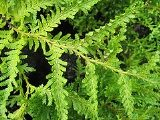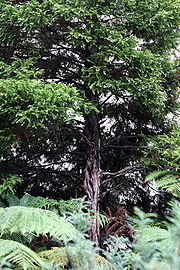
Libocedrus plumosa
Encyclopedia
Libocedrus plumosa is a species of Libocedrus
, endemic to New Zealand
, occurring on North Island
, and locally at the north end of South Island
near Nelson
(41° S). It grows from sea level up to 600 m altitude in temperate rainforest
s. It is threatened by habitat loss.
 It is an evergreen
It is an evergreen
coniferous
tree
growing to 30–35 m tall, with a trunk up to 3 m diameter. The foliage is arranged in flattened sprays; the leaves
are scale-like, arranged in opposite decussate pairs on the shoots; the facial leaves are 1–2 mm long and 1 mm broad, and the lateral leaves distinctly larger, 2–5 mm long and 1.5–2 mm broad. The seed cones
are cylindrical, 12–18 mm long, with four scales each with a prominent curved spine-like bract; they are arranged in two opposite decussate pairs around a small central columella; the outer pair of scales is small and sterile, the inner pair large, each bearing two winged seed
s. They are mature about six to eight months after pollination. The pollen cones are 3–5 mm long.
It has been planted in several parts of the British Isles
, even as north as Castlewellan
, Northern Ireland
.
Libocedrus
Libocedrus is a genus of five species of coniferous trees in the cypress family Cupressaceae, native to New Zealand and New Caledonia. The genus is closely related to the South American genera Pilgerodendron and Austrocedrus, and the New Guinean genus Papuacedrus, both of which are included within...
, endemic to New Zealand
New Zealand
New Zealand is an island country in the south-western Pacific Ocean comprising two main landmasses and numerous smaller islands. The country is situated some east of Australia across the Tasman Sea, and roughly south of the Pacific island nations of New Caledonia, Fiji, and Tonga...
, occurring on North Island
North Island
The North Island is one of the two main islands of New Zealand, separated from the much less populous South Island by Cook Strait. The island is in area, making it the world's 14th-largest island...
, and locally at the north end of South Island
South Island
The South Island is the larger of the two major islands of New Zealand, the other being the more populous North Island. It is bordered to the north by Cook Strait, to the west by the Tasman Sea, to the south and east by the Pacific Ocean...
near Nelson
Nelson, New Zealand
Nelson is a city on the eastern shores of Tasman Bay, and is the economic and cultural centre of the Nelson-Tasman region. Established in 1841, it is the second oldest settled city in New Zealand and the oldest in the South Island....
(41° S). It grows from sea level up to 600 m altitude in temperate rainforest
Rainforest
Rainforests are forests characterized by high rainfall, with definitions based on a minimum normal annual rainfall of 1750-2000 mm...
s. It is threatened by habitat loss.

Evergreen
In botany, an evergreen plant is a plant that has leaves in all seasons. This contrasts with deciduous plants, which completely lose their foliage during the winter or dry season.There are many different kinds of evergreen plants, both trees and shrubs...
coniferous
Pinophyta
The conifers, division Pinophyta, also known as division Coniferophyta or Coniferae, are one of 13 or 14 division level taxa within the Kingdom Plantae. Pinophytes are gymnosperms. They are cone-bearing seed plants with vascular tissue; all extant conifers are woody plants, the great majority being...
tree
Tree
A tree is a perennial woody plant. It is most often defined as a woody plant that has many secondary branches supported clear of the ground on a single main stem or trunk with clear apical dominance. A minimum height specification at maturity is cited by some authors, varying from 3 m to...
growing to 30–35 m tall, with a trunk up to 3 m diameter. The foliage is arranged in flattened sprays; the leaves
Leaf
A leaf is an organ of a vascular plant, as defined in botanical terms, and in particular in plant morphology. Foliage is a mass noun that refers to leaves as a feature of plants....
are scale-like, arranged in opposite decussate pairs on the shoots; the facial leaves are 1–2 mm long and 1 mm broad, and the lateral leaves distinctly larger, 2–5 mm long and 1.5–2 mm broad. The seed cones
Conifer cone
A cone is an organ on plants in the division Pinophyta that contains the reproductive structures. The familiar woody cone is the female cone, which produces seeds. The male cones, which produce pollen, are usually herbaceous and much less conspicuous even at full maturity...
are cylindrical, 12–18 mm long, with four scales each with a prominent curved spine-like bract; they are arranged in two opposite decussate pairs around a small central columella; the outer pair of scales is small and sterile, the inner pair large, each bearing two winged seed
Seed
A seed is a small embryonic plant enclosed in a covering called the seed coat, usually with some stored food. It is the product of the ripened ovule of gymnosperm and angiosperm plants which occurs after fertilization and some growth within the mother plant...
s. They are mature about six to eight months after pollination. The pollen cones are 3–5 mm long.
It has been planted in several parts of the British Isles
British Isles
The British Isles are a group of islands off the northwest coast of continental Europe that include the islands of Great Britain and Ireland and over six thousand smaller isles. There are two sovereign states located on the islands: the United Kingdom of Great Britain and Northern Ireland and...
, even as north as Castlewellan
Castlewellan
Castlewellan is a village in County Down, Northern Ireland. It is beside Castlewellan Lake and Slievenaslat mountain, southwest of Downpatrick. It lies between the Mourne Mountains and Slieve Croob. It had a population of 2,392 people in the 2001 Census....
, Northern Ireland
Northern Ireland
Northern Ireland is one of the four countries of the United Kingdom. Situated in the north-east of the island of Ireland, it shares a border with the Republic of Ireland to the south and west...
.
See also
- Libocedrus austrocaledonicaLibocedrus austrocaledonicaLibocedrus austrocaledonica is a species of Libocedrus, endemic to New Caledonia, occurring mainly in the southern half of the island , at 750–1,400 m altitude in montane cloud forest scrub....
- Libocedrus bidwilliiLibocedrus bidwilliiLibocedrus bidwillii variously called Pāhautea, Kaikawaka or New Zealand cedar is a species of Libocedrus, endemic to New Zealand on both the North and South Islands; on the North Island, it occurs from Te Aroha southward...
- Libocedrus chevalieriLibocedrus chevalieriLibocedrus chevalieri is a species of Libocedrus, endemic to New Caledonia, occurring in three small, isolated populations on low mountain summits at 650–1,620 m altitude in cloud forest scrub on serpentine soils...
- Libocedrus plumosa
- Libocedrus yateensisLibocedrus yateensisLibocedrus yateensis is a species of Libocedrus, endemic to New Caledonia, occurring in a few small, isolated populations in low altitude riverside sites at 150–600 m altitude in rainforest scrub. It is threatened by habitat loss....

